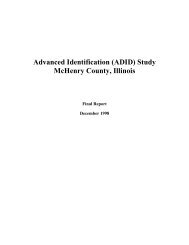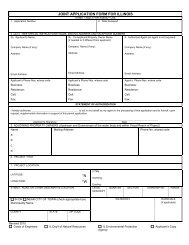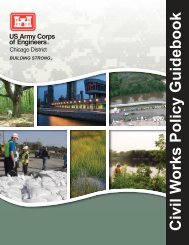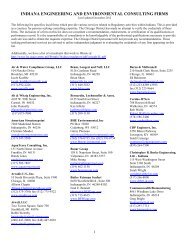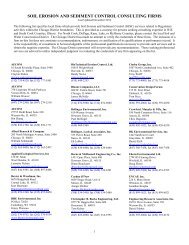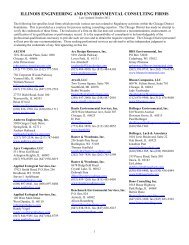Appendix G - Geotechnical Analysis - Chicago District - U.S. Army
Appendix G - Geotechnical Analysis - Chicago District - U.S. Army
Appendix G - Geotechnical Analysis - Chicago District - U.S. Army
Create successful ePaper yourself
Turn your PDF publications into a flip-book with our unique Google optimized e-Paper software.
DESIGN ANALYSIS<br />
Purpose<br />
25. The purpose of this analysis is to determine the constructability of the earthen<br />
structures based on the limited amount of subsurface investigation completed as part of<br />
this feasibility study. Poorly suited soils will be identified, such as organic soils and<br />
coarse grained soils where seepage is disadvantageous. Settlement of levees and<br />
reservoir berms were analyzed using procedures outlined in EM 1110-1-1904. Slope<br />
stability and seepage of levees and reservoir berms was analyzed using SLOPE/W and<br />
SEEP/W software, respectively. <strong>Analysis</strong> for structures such as road raises, floodwalls,<br />
pump stations, spillways, etc. will be completed during the design phase.<br />
Lake Mary Anne Pump Station (FPCI01) – Plate 1<br />
26. Analyses could not be done for the Lake Mary Anne Pump Station as soil borings<br />
were not completed prior to this feasibility report. Based on the USDA Soil Survey, this<br />
site is anticipated to encounter mostly silt and clay soils which would be appropriate for<br />
construction of a pump station and underground pipe. A subsurface investigation will be<br />
required prior to the design phase to determine more accurate information.<br />
27. The Illinois Department of Transportation provided the as builts for two existing<br />
drainage pipes that run parallel with Golf Road. One pipe is a 96 inch storm sewer which<br />
runs along the south side of Golf Road and is between elevations of about 620 to 630<br />
NGVD. The other pipe is also a storm sewer that is 18 inch diameter and runs along the<br />
center of Golf Road between elevations 640 and 635 NGVD. The proposed pipe<br />
connecting the lakes should take care to avoid these pipes.<br />
28. To construct the pipe that connects the two lakes, the most feasible method is to<br />
directional drill beneath the existing utilities. The IDOT as builts include a soil profile,<br />
which indicate that sandy layers were encountered as deep as elevation 622 NGVD and<br />
the water table around 631 NGVD. Therefore, the new pipe should be constructed<br />
around elevation 615 to 620 NGVD to avoid the existing pipes and be fully in the clay<br />
till. Soil borings should be completed to create a soil profile along the proposed drive<br />
line.<br />
Bull Creek Reservoir (BCRS02) – Plate 2, 2a (removed from consideration)<br />
29. The main obstacle in designing a reservoir at the Bull Creek site is the presence of<br />
‘Houghton Muck’ soils consisting of organic clay and peat, as shown on Plates 2 (plan)<br />
and 2a (profile). This layer is highly compressible and therefore requires remediation to<br />
reduce settlement after construction.<br />
15<br />
P:\PRJ-Des Plaines II\TS-DG <strong>Geotechnical</strong>\Feasibility <strong>Appendix</strong>\Des Plaines II Geotech <strong>Appendix</strong> 082713.Doc



